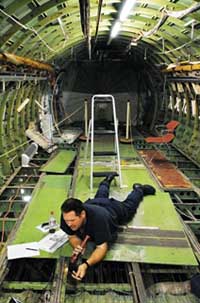NEWS RELEASES
FOR IMMEDIATE RELEASE
August 20, 2007
Sandia hosts aircraft inspectors for training in inspection technology
Retired Sandia aircraft serving as testing ground
ALBUQUERQUE, N.M. —Dozens of aircraft inspectors from the U.S. Coast Guard are in Albuquerque this week for a unique weeklong training course hosted by Sandia National Laboratories. Inspectors from the U.S. Air Force and commercial aircraft operators are attending the training as well.
The workshop is giving specialists responsible for the safety of government and corporate aircraft valuable experience using high-tech sensors and scanners to help them find small or hidden cracks and other flaws in aircraft structures early in their formation, before the defects become a safety hazard.
Members of the news media are invited to visit the Airworthiness Assurance NDI Center hangar (3260 Spirit Drive SE, east of the Sunport rental car center) Tuesday through Friday this week, where inspectors will be using sensors to find defects in retired aircraft. Please call 844-5199 to make arrangements to visit the hangar and interview participants.
The training is being held at a unique facility near the Albuquerque International Sunport, the Airworthiness Assurance Non-Destructive Inspection Validation Center (AANC), which houses several retired aircraft with known defects in their structures. The AANC’s focus is extending the service lives of aging aircraft by using advanced inspection and repair technologies.

Adam Hoke, an aviation maintenance technician with the U.S. Coast Guard, inspects the belly of a Boeing 737 using an eddy current scanner. (Photo by Randy Montoya)
Download 300dpi JPEG
(Media are welcome to download/publish this image with related news stories.)
Sandia, a National Nuclear Security Administration laboratory, operates the center for the Federal Aviation Administration.
The center has developed and/or evaluated several hand-held systems that aid inspectors in finding defects too small or too hidden to be seen with the human eye. Such inspections are strictly regulated to maintain a high degree of aircraft safety.
During their training, the inspectors will try to locate and characterize defects in the following aircraft: 727, 737, 747, DC-9, Fairchild Metroliner, Dassault Falcon 20 & 25, Bell Sea Ranger helicopter, and Huey HU1 helicopter. The workshop is sponsored by the U.S. Coast Guard as part of ongoing inspector training.
Nondestructive inspection (NDI) refers to techniques for checking airframe components for unseen defects, such as cracks and corrosion in materials, without disassembling the aircraft. Sandia’s research in NDI since 1991 has resulted in the development and certification of a variety of aircraft inspection and repair technologies now used in the commercial and government aviation sectors (www.sandia.gov/news/resources/releases/2007/aircraft.html).
“While retired aircraft can be obtained from aircraft boneyards, there is no place else in the world that has aircraft with characterized defects,” says Sandia engineer Mike Bode of the AANC.
He says the workshop is a great example of cooperation among government agencies and private sector officials, who have the common goal of increasing the proficiency of inspectors who do critical safety assessments of aircraft.
The program supports the Department of Homeland Security’s U.S. Coast Guard aging aircraft program. A similar program with Dassault Falcon Jet provides similar training to corporate and business jet inspectors.
Sandia is a multiprogram laboratory operated by Sandia Corporation, a Lockheed Martin company, for the U.S. Department of Energy’s National Nuclear Security Administration. With main facilities in Albuquerque, N.M., and Livermore, Calif., Sandia has major R&D responsibilities in national security, energy and environmental technologies, and economic competitiveness.
Sandia news media contact: John German, jdgerma@sandia.gov,(505) 844-5199